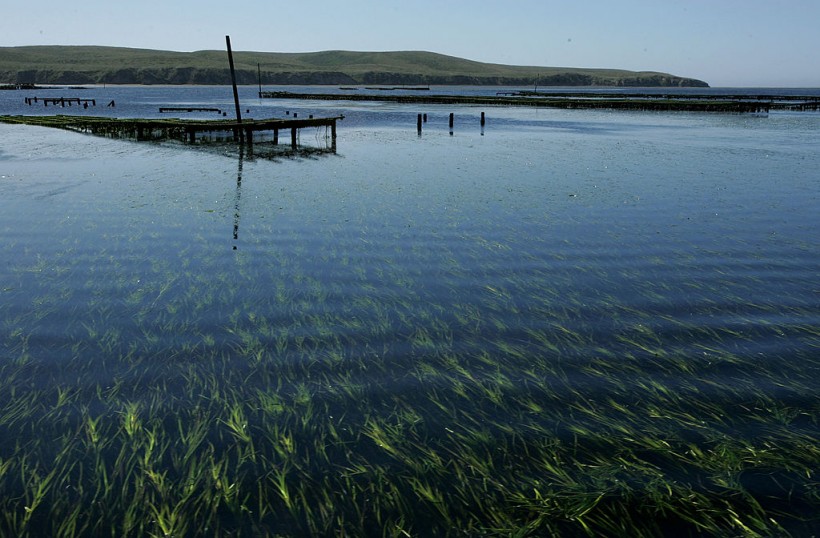Eelgrass is a group of seagrasses that grow in shallow coastal waters around the world.
They are important ecosystem engineers that provide habitat, food, and oxygen for a variety of marine organisms, as well as services such as sediment stabilization, nutrient cycling, and carbon sequestration for humans.
Eelgrass also has a long history of use by humans for food, medicine, packing, thatching, and insulation.
But how did eelgrass spread around the world, and what factors influenced its distribution and diversity?
The origin and evolution of eelgrass
 (Photo : Justin Sullivan/Getty Images)
(Photo : Justin Sullivan/Getty Images)

Eelgrass belongs to the family Zosteraceae, which is one of the oldest lineages of flowering plants that adapted to marine life, as per Phys.org.
The fossil record suggested that Zosteraceae originated in the late Cretaceous period, about 100 million years ago, when the sea level was high and the climate was warm.
The earliest fossils of Zostera are from the Paleocene epoch, about 60 million years ago, in Europe and North America.
Eelgrass diversified into several species and subspecies over time, in response to changes in climate, sea level, salinity, and tectonics.
Molecular phylogenetic studies have shown that Zostera has two major clades: one that includes the temperate species Z. marina, Z. angustifolia, Z. noltei, and Z. muelleri; and another that includes the tropical and subtropical species Z. capensis, Z. chilensis, Z. japonica, Z. asiatica, Z. caespitosa, Z. polychlamys, Z. nigricaulis, Z. capricorni, Z. mucronata, and Z. tasmanica.
The temperate clade is thought to have originated in the northern Atlantic Ocean during the Oligocene epoch, about 30 million years ago, and then dispersed to other regions during the Miocene epoch, about 20 million years ago.
The tropical and subtropical clade is thought to have originated in the Indo-Pacific region during the Miocene epoch, and then dispersed to other regions during the Pliocene epoch, about 5 million years ago.
Also Read: Study Shows How Previous Ice Ages Influenced How Seagrass Reacts to Modern Environmental Threat
The current distribution and diversity of eelgrass
Eelgrass is currently distributed in temperate and tropical regions of the northern and southern hemispheres, with a total of 15 species and several subspecies recognized, as per Britannica.
It can grow in a range of habitats, from intertidal to subtidal zones, from sandy to muddy substrates, from estuaries to open coasts. Plus, it can tolerate a range of salinities, from freshwater to hypersaline conditions.
The global distribution of eelgrass is influenced by several factors, such as temperature, light availability, water depth, wave exposure, herbivory, competition, disease, and human impacts.
Eelgrass generally prefers cooler waters with high light penetration and low wave energy. It is sensitive to temperature extremes and can experience die-offs or declines during heat waves or cold snaps.
Furthermore, eelgrass is also vulnerable to light reduction caused by turbidity or eutrophication. It can be grazed by animals, such as geese, turtles, fish, and sea urchins, or outcompeted by algae or other seagrasses.
The plant can be infected by pathogens, such as Labyrinthula zosterae, which causes wasting disease, or affected by invasive species such as Caulerpa taxifolia or Sargassum muticum. It can also be damaged or destroyed by human activities such as dredging, trawling, coastal development, or pollution.
Despite these threats, eelgrass also has some adaptive strategies that help it survive and spread. It can reproduce sexually by producing flowers and seeds that are pollinated underwater and dispersed by water currents or animals.
However, eelgrass can also reproduce asexually by producing rhizomes and shoots that can colonize new areas or recover from disturbances. It can also form hybrid zones where different species or subspecies interbreed and create genetic variation.
This plant is a valuable component of marine ecosystems and a useful indicator of environmental health.
Understanding its origin, evolution, distribution, and diversity can help us conserve and restore this global seagrass.
Related article: Mysterious Underwater Fairy Circles Explained
© 2024 NatureWorldNews.com All rights reserved. Do not reproduce without permission.

![Climate Change is Reducing Dust Levels Worldwide as Arctic Temperature Warms [Study]](https://1471793142.rsc.cdn77.org/data/thumbs/full/70320/280/157/50/40/climate-change-is-reducing-dust-levels-worldwide-as-arctic-temperature-warms-study.jpg)
![Tsunami Hazard Zones: New US Map Shows Places at Risk of Flooding and Tsunamis Amid Rising Sea Levels [NOAA]](https://1471793142.rsc.cdn77.org/data/thumbs/full/70325/280/157/50/40/tsunami-hazard-zones-new-us-map-shows-places-at-risk-of-flooding-and-tsunamis-amid-rising-sea-levels-noaa.jpg)


